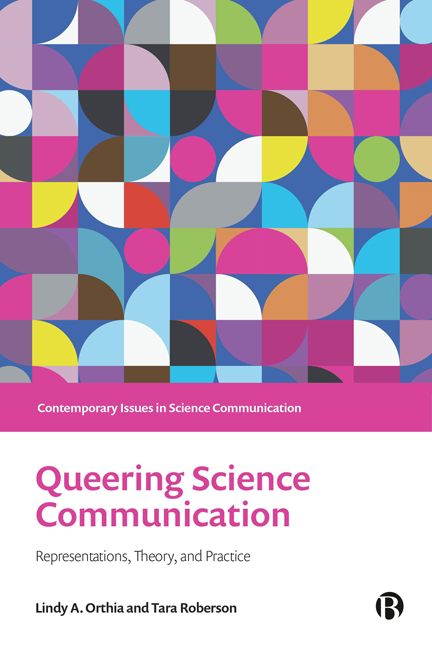Book contents
- Frontmatter
- Contents
- Series Editor Preface
- Notes on Contributors
- Acknowledgements
- Terminology and Sensitive Content in This Book
- Introduction
- PART I Negotiating Queer Identities with Science, Technology, and Medicine
- PART II Representations of Queerness in Public Science Communication
- PART III Queer People in Science Communication Communities
- PART IV Queering Institutional Science Communication Agendas
- Conclusions
- Index
4 - Queering Science Museums, Science Centres, and Other Public Science Institutions
Published online by Cambridge University Press: 18 January 2024
- Frontmatter
- Contents
- Series Editor Preface
- Notes on Contributors
- Acknowledgements
- Terminology and Sensitive Content in This Book
- Introduction
- PART I Negotiating Queer Identities with Science, Technology, and Medicine
- PART II Representations of Queerness in Public Science Communication
- PART III Queer People in Science Communication Communities
- PART IV Queering Institutional Science Communication Agendas
- Conclusions
- Index
Summary
Queering the scene at the science institution
While approaches to queer interrogation/integration within arts and socio-historical museums are well documented (for example, Sullivan and Middleton, 2019), there is little yet written on the value of extending this approach to public science institutions. In this chapter, we think about queering public science institutions. Here we argue that that queer/ing can (and should) be an equally valuable lens for science, technology, engineering, mathematics, and medical (STEMM) institutions. We use the phrase ‘public science institutions’ to describe a myriad of locations where everyday STEMM learning is performed and received publicly through science communication. We also recognize that many of these public science institutions are active sites of scientific research too (for example, Singapore Botanical Gardens, American Museum of Natural History); and as such they are not only representing science but also creating the very knowledge they represent. Thus, we collate here some ideas and directions spanning zoos, botanical gardens, natural parks, farmyards, makerspaces, aquaria, open air science sites, as well as science museums and science centres, that are aimed to direct the reader to ways of engaging queer theory in science communication practices and institutions in all these contexts. However, in writing this chapter we acknowledge that any queer work can never be definitive: thus we encourage unpicking and redeveloping these in any future queer interventions into science institutions.
Public science institutions have multiple valences for publics as sites of leisure, sites of learning, or sites of (un)official pedagogy. Underpinning these, such institutions are also part of projects to create and uphold the social and structural norms of societies they claim to represent. This can be seen in existing science institution theorizing that focuses on who is in the audience at the institution, highlights who is not ‘learning’ to be part of the society, and interrogates what norms are being communicated as knowledge to learn (Dawson, 2019). As per other scholars (for example, Cassidy et al, 2016), we thus recognize the political implications of ‘rendering things up to be viewed – [as] a key means of apprehending and “colonizing” reality’ (Macdonald, 1998, p 10) in the process of display and representation of (scientific) knowledge.
- Type
- Chapter
- Information
- Queering Science CommunicationRepresentations, Theory, and Practice, pp. 71 - 88Publisher: Bristol University PressPrint publication year: 2023

